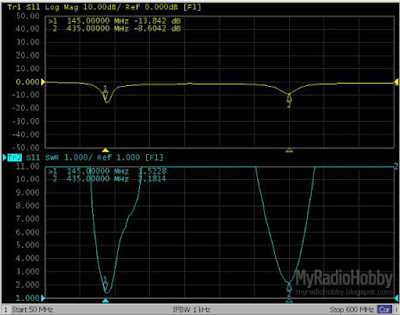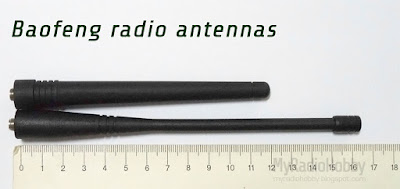Practically all handheld radios are sold with a small whip or "rubber duck" type antenna. Sometimes this antenna is so small than it is not even 1/4 wave length at UHF (440Mhz). As you probably know, these small antennas are not very performant, specially on the VHF band (136-174Mhz), where the whip is so short that performance is severely affected.
For better performance a bigger antenna is needed. The Nagoya NA-771 is a dual band VHF/UHF (144/430Mhz) antenna that delivers improved performance compared to the typical "stock" whip or "rubber duck" antennas. The Nagoya NA-771 is about 39cm in length, much bigger than the typical handheld radio "stock" antenna, but still a good match for small handheld radios. For a review of the Baofeng antennas that come with Baofeng handheld radios, please check my previous post.
 |
| Nagoya NA-771. |
 |
| Disassembled Nagoya NA-771 with matching circuit. |
As always, the laws of physics rule and, as expected, compared to the antennas that come with most portable radios (Baofeng and others), performance is noticeably better, specially in the VHF 2 meter band and the commercial FM band. But UHF performance is also improved. Nagoya claims a gain of 2.15 dBi and a VSWR of less than 1.5:1. I don't trust this specs since this is a 5/8 wave antenna and a higher maximum gain is to be expected. A 5/8 wavelength pole has more gain at lower elevation angles (i.e. near the horizon) than a 1/4 wave pole, which it is what is normally desired. Also, Nagoya's claims the same gain for the NA-701, a much smaller antenna! Don't confuse the NA-771 with the NA701, which is only 22 cm in length. The NA-771 has more gain than the NA-701!
 |
| Nagoya NA-771 VSWR and Return Loss chart. |
Some people say that the NA-771 is no better than the "stock" antenna that comes with your radio. That is not my experience. Probably they have a negative opinion of the NA-771 because their antenna is defective. Unfortunately it seems that many NA-771's sold are not the original product, but imitations!
A "fake" NA-771 antenna could be as good as a genuine Nagoya NA-771, but you are more likely to get a defective product. In case of the NA-771, if your new NA-771 offers no improvement over the smaller stock "rubber duck" antenna, probably you where sold a defective antenna. If you were to disassemble the antenna you would probably find a bad solder joint in the matching circuit.
A "fake" NA-771 antenna could be as good as a genuine Nagoya NA-771, but you are more likely to get a defective product. In case of the NA-771, if your new NA-771 offers no improvement over the smaller stock "rubber duck" antenna, probably you where sold a defective antenna. If you were to disassemble the antenna you would probably find a bad solder joint in the matching circuit.
You can buy a NA-771 for about 4 USD delivered from Banggood here.



